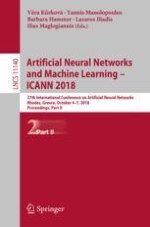2018 | OriginalPaper | Chapter
Fast Supervised Selection of Prototypes for Metric-Based Learning
Author : Lluís A. Belanche
Published in: Artificial Neural Networks and Machine Learning – ICANN 2018
Publisher: Springer International Publishing
Activate our intelligent search to find suitable subject content or patents.
Select sections of text to find matching patents with Artificial Intelligence. powered by
Select sections of text to find additional relevant content using AI-assisted search. powered by
